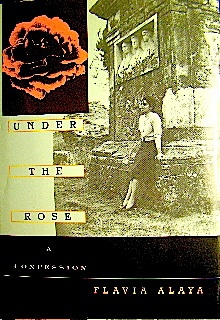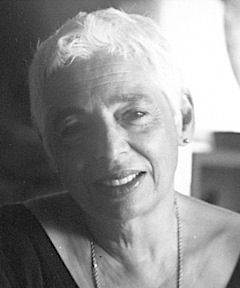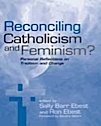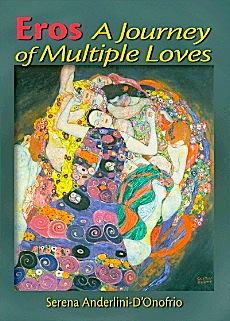

Hello, campers –
Yes, I know: we’ve been trying to polish off our ongoing series on polishing up a query letter, but now that the holiday weekend is upon us, I thought we should pause, take a breath, and celebrate just how much work all of you have done throughout this series — or, depending upon your reading habits, give some of you time to catch up. Hey, query-writing is hard stuff.
Which is why I am so delighted to bring you my promised reward for virtue: a fascinating post on dealing with having one’s book reviewed by memoirist and nonfiction writer Flavia Alaya, author of the incredibly brave and revealing UNDER THE ROSE: A CONFESSION, among many, many other works. (Seriously, her bio will astound you — see the end of this post.) From the publisher’s blurb:
Beneath its “scandalous” surface, Flavia Alaya’s story goes to the heart of women’s struggles for independence, self-definition, and sexual agency. When she first met Father Harry Browne, Alaya was a vibrant but sheltered young woman on a Fulbright scholarship to Italy. When the attraction that began in a cafe in Perugia became too compelling to resist, they embarked on a love affair that violated some of the deepest taboos of society, the Church, and her Italian American family, yet endured for over two decades, through years of shared dedication to social activism and through the birth of three children.
Intriguing, no? From the slightly more revealing Library Journal review:
At 22 years of age, in a cafe in Italy, Alaya met fellow Fulbright recipient Harry Browne, 16 years her senior. Raised in New York’s Hell’s Kitchen, Browne was a social activist, a historian — and a Catholic priest. Their relationship endured for over 20 years, producing three children and seemingly sustaining both extraordinary parties quite well. Not a martyr to love, Alaya was able to hold onto independence and self-possession while experiencing a profoundly passionate attachment to a fascinating human being. Through the bonding of social activism, Browne and Alaya weathered many civil rights storms, the 1960s antiwar movement, and a grass-roots campaign against a New York real estate grab. Browne championed the poor and fought to better their housing situation; Alaya wrote scholarly articles on 19th-century literature. The relationship’s secrecy (it was hidden “under the rose”), its continual trials and stress, and the ousting of Browne as priest when it was discovered pull the reader along for the ride with elegiac style.
And the still more descriptive ForeWord review:
She was a twenty-two-year-old Fulbright scholar from New York fleeing her immigrant Italian family’s claustrophobic love, he was a thirty-eight year old Catholic priest from the city’s Irish tenements of Hell’s Kitchen, researching Church archives. They met in a Perugia café in 1957: a thunderbolt, opera’s grand coup de foudre of destiny.
Their affair, shamelessly shameful, was to be sub rosa, under Cupid’s rose of secrecy. In small rented rooms, in the fervid, emotive culture, Italy itself seemed to become their duenna and collaborator. They returned to New York, she to an apartment on the Upper West Side, he (as fate would have it) to a parish blocks away, the fiction of their friendship so carefully maintained that not even her own family knew the father of her children. Ironically, their private war against the Church’s conservative patriarchy augured the decade’s larger battles of civil disobedience and feminist freedom. With their own adopted neighborhood soon slated for massive urban renewal, which would displace so many working poor, Father Harry Browne moved quickly into political activism. (It was in Father Browne’s office that the FBI arrested Father Berrigan, notorious for burning Pentagon draft records to protest the Vietnam War.) Thus, as in opera as in life, love and politics are ever held close, one of the many paradoxes Alaya so lovingly, so wisely ponders in Under the Rose.
Those asking for theology or psychotherapy may be disappointed, but those asking for well-written honesty will be handsomely rewarded. In a poignant, lucid language that combines the pace of fiction with the intimacy of a love letter, her “memory-ghosts” bring private and social history to full circle, the story of an immigrant’s search for freedom of expression. Under the Rose is the very model of memoir writing, of a woman’s voice finally finding perfect pitch.
Why am I showing you three different plot summaries, you ask, rather than just the usual publisher’s blurb? For a couple of reasons, one pertaining to our series-in-progress, one to today’s topic.
First, did you notice anything about those three descriptions of the same book? The first two were of reasonable lengths to use as the summary paragraph of a query letter — 99 and 162 words, respectively. So what makes the first strong back jacket copy, but the second a better bet for a query or pitch?
If you immediately cried, “By gum, Anne, the vivid details in the second!” give yourself a gold star for the week: you’ve been paying attention. The specifics really make a difference in the storytelling department, don’t they, even in so short a piece?
If you also shouted, “The blurb reviews, while the second demonstrates why a reader might be interested in the book,” award yourself a second gold star. Heck, take yourself out for an ice cream sundae: that was an astute observation.
But wait; today’s pop quiz is not over yet. Since the first two descriptions illustrated my ongoing point so beautifully, any guesses about why I saw fit to include the third?
Hint: the answer lies in the word count.
Okay, I’ll just give you this one: at 302 words, it would make a pretty good 1-page synopsis. You know, the kind that agencies’ websites and agency guides’ listings keep asking writers of 350-page books to send with their queries and/or pages. True, the last paragraph is pure review, as is the last sentence of the second.
But it just goes to show you: it is indeed possible to give the contours of a story in that number of words without resorting to blurry generalities. No matter how many times you re-checked that requirement on the agent of your dreams’ website, hoping you had misread it, it’s actually not all that unreasonable a request.
The second reason to walk you through all of those reviews was even more straightforward: Flavia’s going to talk to us today about what it’s like to get a book reviewed. And not necessarily nicely.
One of the classic writerly fears, right? Flavia is going to tell us how to confront it straight-on, instead of running away screaming.
I’m very excited about this guest post, and not merely because, as those of you who have been dropping by Author! Author! for a while are no doubt already aware, I’m a huge fan of wrestling those big, bad writerly fears out into the open, examining them thoroughly, and talking about how to deal with them practically. There’s been a lot of talk on the conference circuit lately about career writers, the kind who have more than one book in ‘em.
Career writers’ work used to be considered the backbone of the publishing business, you know. A blockbuster may sell a million copies on a fluke, but authors whose established readerships kept returning for subsequent books provide publishers with consistent, relatively predictable income. With the decline of the multi-book contract, however, many agents in recent years had become less interested in hearing about a prospective clients’ other book ideas than in whether the manuscript in front of them might be the next breakout hit.
With the economic downturn, however, the phrase career writer has been turning up on more and more lips. It’s not even all that unusual these days for agents to ask newly-signed clients to come up with one-paragraph descriptions of their next three or four projects, just to have at the ready in case an editor impressed with a manuscript asks.
Don’t tense up; start brainstorming.
As this trend has been heating up in recent months, I’ve been eagerly blandishing career writers to come and share their insights with our little writing community. You want to know what a long-term career strategy looks like, don’t you?
So please join me in welcoming Flavia Alaya, career writer and memoirist extraordinaire. But before I hand you over to her, let me add: UNDER THE ROSE is available on Amazon and, of course, directly from the publisher. Oh, and that lovely photo of Flavia above was taken by Ellen Denuto.
Take it away, Flavia!




Under the Rose is memoir as collage—less in style than in process. When it began its manuscript life, the book was the relatively brief and tidy account (with a few flashbacks) of my first 13 or so years with Harry, in Italy, then in New York—essentially our secret life together…sub rosa, or “under the rose.” When the manuscript (which was sold three times over 16 years of writing and rewriting—long story!) was finally acquired by The Feminist Press and positioned for their Cross-cultural Memoir Series, publisher Florence Howe asked to see the core theme in the context of a “life.” This meant weaving two or three more complex narratives into the original—the back-stories (what was it in both our early lives made us able to tolerate, maybe even need, that kind of secrecy?) and the post- and post-post-scripts: how we both met the critical test of going public, and then how I faced life without him when he died.
A challenge. Many challenges. First, unpacking more hard truths about my family—and his—than I’d ever intended to. Then (harder) untangling the sticky weave of that final public decade together in the ‘70s, when we struggled to float the flimsy raft of a “liberated” partnership—with three small kids nailed to it—through virtual tsunamis of academic and ecclesiastical politics. Not only did I have to tear the book apart and reassemble it. I had to back off from it. I had to take the entire project (which had seemed so obvious and simple, once) more seriously…and myself less. Much less.
Which is one reason this review struck me as so baffling:
What is the point of her ‘confession’? That she’s a good and put-upon person? If so, it is better left to others to make the point for her; none of us can afford the luxury of publishing our questionable righteousness.
A bite, a mere rebarbative nine-year-old mouthful of what used to be standard Barbara Grizzuti Harrison agita in The New York Times Book Review…except that it was directed at me and my memoir.
Baffling. Because if I’d had my way, Under the Rose would have been subtitled, with obvious irony: “A Life in Six Operas.” Even the present “Confession” has its edge—absolution was the last thing I was looking for! But here was the Press again, hoping a more salty subtitle might trump their off-putting imprint and win them some new readers. Inside, however, opera names still define the book’s six parts (Tosca, Gioconda, Traviata, etc.), and adjust the tone (or so I thought) in two self-satirical ways, denoting the spectacular Italian American family culture I grew up in, first, and then caricaturing the over-the-top romanticism I’d internalized with it. Maybe it was a complex way to suggest, as a part of the theme, why my inner diva took so very long to outgrow, and why it cost so much tearing of heart muscle. But I didn’t think it inaccessible, especially to a Times reviewer.
On the other hand…
Well, on the other hand, Harry was a very funny man. You couldn’t take him anywhere—not without pulling a crowd that would quickly be doubled over in bodily pain. No invidious comparisons with great Italian literature are intended, but maybe Under the Rose should come with a warning label: if clerical sex doesn’t make you laugh, close the book. Or burn it.
I girded myself to reread the review for this blog, but I was sure I could deal with it. I was way too sensitive then. And besides, she’s dead. And besides, nine years is long enough.
But no, the bloody thing still had its ghoulish way with me, like a Dracula lover. Be objective, I tell myself. And I am. Objectively, it must be one of the most venomous reviews of a memoir ever to appear in The New York Times Book Review. OK, limit the sample to ex-editor Charlie McGrath’s wrathful-God Book Review universe, where there were body-counts. The citation still stings.
Right now, you know what I’m thinking? I’m thinking it would be really nice if you’d take my word for it, but I bet you feel double-dared to go and read it. Well, damn you, go ahead. But come back afterward, because that review never should have been the end of it—not for me, but not even for her.
Here it is.
OK. Agree with me on this, that what Harrison’s maundering few-hundred words are unleashing is disgust, a given, a natural response to the book’s basic and objectively revolting premise, that I actually had an underground career as a priest’s “wife.” Well, it is objectively revolting, isn’t it? For an Opus Dei sort like herself, of whom it could be said—and was—that the Curia was kindlier and less Roman? Please.
And now, seeing as Roman is the only form of Catholicism to demand a pretense of lifelong eunuchry in its priesthood, channel the fair-minded editor of the Book Review assigning the book to her: who could be more qualified to review a challenge to the ideal of Catholic celibacy? Let her rip! “Fortunately Alaya loves herself sufficiently, {sic} to relieve the reviewer of any obligation to protect her ego.”
Ah, what fortress faith, what crusading passion, to crush the nano-flash of pity that inspired that line. I still find it hard to get past it.
Pearl of Writerly-Wisdom #1:
A brutal review goes straight to your voice. For a while it’s as if somebody has carved out your larynx with a bread-knife and you keep on trying to make the breath you still push through the replacement tube sound like you.
For years I’ve twitched whenever people said they’d come across that review on the web. Sure, I was onto Grizzuti’s rap-sheet as hitwoman, but what was I supposed to say? That she’d slashed the likes of Joan Didion and Spike Lee too, and look at the company I’m in?
There are some reviews you should never read twice, unless you have another larynx to turn. No, nine years are not enough. And now Google can serve up Grizzuti’s little murder, on demand, to me or anybody looking for me, almost always at the top of the hit-list. Maybe forever—all the forever that matters to a writer.
There’s a silly analogy to Keats’s urn in here somewhere. Instead of those lovers forever yearning toward each other to the sound of a silent flute, there’s this worthless writer forever pinioned by this bloody reviewer’s disgust, somehow never able to “love herself sufficiently” to get outside that shell of ego-protecting denial.
But…
Pearl of Writerly-Wisdom # 2:
You don’t stop talking just because you get told to shut up. I’m not saying you shouldn’t, just that you don’t. And, yes, you probably shouldn’t.
Maybe stories like this don’t end till you really go silent. As self-writing goes, let’s just say I’m probably at the end of the middle of whatever story this is, where I gravitate to scholars of autobiography and reflect on their wisdom. Lauren Berlant is one. She says in pretty good academy-speak that to write the self is to try to create “a spectacular interiority worthy of public notice” (The Queen of America Goes to Washington City, 1997).
I love the compression of this. Right at the top it says that you’re making a spectacle of yourself, which I admit I have done, and still do.
But the “worthy of public notice” part? That’s the paradox for Berlant to unfold. If the interior self you’re exposing isn’t normative, if it’s different in a way not embraced by the larger culture, or if what you’re exposing—maybe a hidden truth or reality, an injustice—is something the majority culture (or somebody in its service) would rather not see exposed, then it’s difficult to make it “worthy” of public notice, isn’t it.
Except perhaps over time, and in this sense, to write the truly “spectacular” self is to write to the future. Because as you write it, in that time, it must be by definition unworthy, and by somebody’s standards even shameful, or better, shameless. Something to be pilloried, in service to the spectacle of your shamelessness.
Pillory this. Grizzuti and the Times did, bless ‘em, and I guess from that perspective there‘s an edge of flattery in it. Otherwise, why me? Under the Rose, my first non-academic book, had come out of CUNY’s Feminist Press, so minor and semi-academic a publishing house by Times standards that not one of its best books had yet had a single dedicated review within their pages. Mine should have been an equivalent non-event, yet they gave it a full-page that Sunday, with artwork, no less, page 9.
John Updike was there a week later.
Maybe BGH hated my book for good literary reasons, but I doubt it. Her deft surgical skills were simply at the service of a special version of the normative—hers, of course, but also the Times‘ then, before the scandals that made Catholic pretensions to purity fair game. You and I know that if it were true that “none of us can afford the luxury of publishing our questionable righteousness,” there’d be a lot fewer book reviews than memoirs.
This is good to remember, to score up there on the wall (as one of my writer-friends does) with other great self-help mantras. It also self-helped (it still does) that Under the Rose went to press with the imprimaturs not just of Marilyn French but of Nuala O’Faolain and Sandra Gilbert, both brilliant memoirists, both sometime Catholics, and both household saints in my calendar. I wonder by my own litmus test whether I really was “writing to the future” if some pretty testy other reviewers said some pretty nice things about Under the Rose in some pretty good places.
But back then, of course, in the fresh wake of Grizzuti, it didn’t matter who liked it. Behind that thick bark of ego she gave me there was barely a trickle of self-love left for savoring praise. Only weeks before that review was published my father had died—the patriarch who’d figured so huge in my story that I’d once actually thought of calling it Father—and the very Sunday it appeared I was in flight to California to help empty his house.
For a while, I’d say his death probably silenced me more than Grizzuti. Remembering it now makes me wonder what else I lost, or had to lose? Well, some things I thought I wanted, like the respect of my academic colleagues, the more careerist of whom instantly smelled Times roadkill and cut me off. It took awhile for me to see that academic cachet was something I’d already begun to de-value—otherwise why write a memoir in the first place? Maybe they’d known that before I did.
Could be, then, whatever else I lost, whatever still hangs somewhere in that vague .alt universe, was some of the same stuff—stuff I only thought I wanted.
Pearl of Writerly-Wisdom #3:
We have more than one life to live, and more than one voice to give.
I had a lot of possible voices from the beginning. So it could be that the right analogy for that review was not a laryngectomy but a stink-bomb. It emptied the building. But it didn’t take long to hear the riot of squatters rumbling up the stairs to fill the place. All those voices! They may have been attached to the same maimed name, but they had something, spectacular or not, still left in them to say.

I was nearly immediately invited to contribute to two anthologies, one a group of Italian American women writing on food and culture (a short story, “Love Lettuce,” to The Milk of Almonds (Feminist Press, 2002); and an essay for a gathering of mostly Catholic feminists on their complicated attachments to the Church (“The Elephant is Slow to Mate” in Reconciling Catholicism and Feminism?, the University of Notre Dame Press, 2003, a publication that, by the way, merits a special little Grizzuti-star).

But my favorite re-gift came from an Italian scholar with a passion for sex and the sacred, Serena Anderlini-D’Onofrio, who trumped the grimly silent Academy (and it must be my formidable ego that makes me LOVE to repeat this story) by making Under the Rose a cameo text at a conference session of the MLA’s annual meeting in New York. (Serena is a serious trip: see her own memoir, Eros: A Journey of Multiple Loves, 2006, and her website.)

And then, as you know, the future—or one of the futures—I was writing to came maybe sooner than anybody expected, and what is fondly termed the Priestly Pedophilia Scandal burst on the culture scene.
Almost immediately, a Dublin publisher (New Island Press) contracted to do their own edition of Under the Rose.

Whereupon the Irish—who live in such an intimately conflicted family relationship with the Church, bought it, read it, reviewed it (quite soberly and generously), eventually made a half-hour TV movie about it, and seemed generally delighted to deflect attention away from the boys, and in the direction of my consensual, heterosexual, and mostly cavorting relationship with an utterly charismatic, brilliantly political, and howlingly funny Irish-American person who was, as it happened, also a priest “to the bone.”
Still, I have never published another book. Those “squatter” voices, a half-dozen or so like this one, slip in and slip away. Some are quite true, not ringers, slowly reclaiming the place now that the furniture in the apartment is a bit ratty but less odiferous.
I keep telling myself I have to get some new furniture. Or a whole new apartment—my ever recidivist self-love certain that there’s an absolutely brilliant historical novel in me…or maybe a series of murder mysteries, a theme on which I’ve become more expert with time.
But I cannot tell a lie. I was probably never meant to tell anything but true stories, truly. I regret that I didn’t devote more craft to making my one big book three smaller and better ones. And now I’d love to pull together a collection of hilariously picaresque true tales about my rogue of a lover-husband on this, my second time around.

FLAVIA ALAYA, who dubs herself “a writer of all work,” professed cultural history at Ramapo College of New Jersey and helped found its original School of Intercultural Studies. (Sub)versions of infamy and secrecy attract her: her first book, a Harvard Press biography of Anglo-Scot writer William Sharp, is the still-standard account of his masquerade as a female poet (“Fiona Macleod”). Later work pioneered a feminist revaluation of Elizabeth Barrett Browning, the disparaged English poet who was, of course, also a consummate (if more discreet) memoirist.
But a little like Elizabeth, Flavia has always been too love-struck for the perfect feminist, and when her partner, star labor and immigration historian—and Roman Catholic priest—Harry Browne, died of leukemia in 1980, the project of writing about him—about them—seemed a way to prolong their life together. The adventures detailed inside this memoir made for a rocky manuscript adventure outside it that didn’t end (as you’ll see) with its publication by the Feminist Press in 1999.
But the “writer of all work” scrubs on, maybe more in the kitchen than the front parlor. As a civil rights advocate post-9/11 she wrote immigration detention exposés (and recounted anti-detention street activism) for the online journal CounterPunch. But always under the spell of city life and culture, her skills have turned not just to preservation activism but to “scripting the (local) landscape” as a form of community resistance to change, a vaguely subversive culture underground. From New York’s West Side to Paterson, New Jersey, small books—hidden histories revealed—like Gaetano Federici: The Artist as Historian, Silk and Sandstone, and Bridge Street to Freedom (a multi-layered account of the landmarking of a station of the Underground Railroad) have become a favorite medium. In collaboration with a local sports maven, she recently unpacked the lively story of Paterson’s Depression-era Negro Leagues stadium into a successful National Register application and a website.
Two Geraldine R. Dodge Foundation writing fellowships at the Vermont Studio Center helped complete her memoir and then carry forward a draft novel on the life and amazing disappeared career of Joseph McDonnell, once-flamboyant Fenian, cofounder of the First International, editor of the long-lived Paterson Labor Standard, and pioneer author of the first progressive labor legislation in New Jersey. She has paused in this unfinished business to script narratives of industrial, labor and women’s history into the landscape of Bridgeton, New Jersey, her new base, as well as home of the largest historic district in the state.